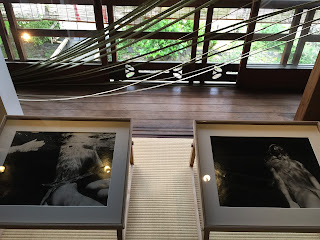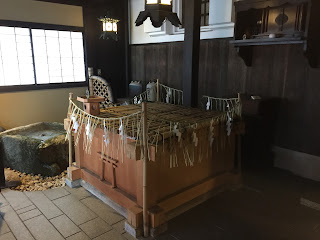2015年の5月に、京都の狩野派展、PARASOPHIA: 京都国際現代芸術祭、KYOTOGRAPHIE 京都国際写真祭 2015、光悦寺などを訪れたときの記録。 In May 2015, I visited to Kano school of Kyoto exhibition, PARASOPHIA: Kyoto International Contemporary Arts Festival, KYOTOGRAPHIE Kyoto International Photography Festival 2015 and Koetsuji so on.
2015年12月26日土曜日
KYOTOGRAPHIE - フォスコ・マライーニ Fosco Maraini
京都、祇園の白川沿いは、京都を代表する風景。
その川沿いに建つ、祇園新橋伝統的建造物では、写真家というよりは、人類学者、東洋学者であるフォスコ・マライーニが、1950年代の能登半島で撮影したという、海女の写真。
川を流れる水の音が涼しげで嬉しい。
こちらの展示方法もユニーク。竹が効果的に使われている。
フォスコ・マライーニの写真の中の海女たちは、ほとんど真っ裸。
形のいい、ふくよかなオッパイが、そこらじゅうに並べられているが、エロチックさはあまり感じず、健康的なエネルギーのようなものが、狭い室内に充満していた。
Kyoto, along Gion Shirakawa, landscape representative of Kyoto.
Built along the river, in the Gion Shinbashi traditional building, rather than a photographer, anthropologist, that it is oriental scholar Fosco Maraini, it was taken by the 1950s Noto Peninsula, flax photos.
The sound of water flowing through the river is nice a cool.
This exhibition method is also unique. Bamboo has been used effectively.
Ama in the picture by Fosco Maraini is, almost completely naked.
The good of shape, plump tits, but are arranged in everywhere, erotic is is not feeling too, is a kind of healthy energy, had filled the narrow room.
(Translated by Google Translate)
KYOTOGRAPHIE - オリバー・ジーバー Oliver Sieber
祇園の街中にある、ASPHODELという会場は、1966年にドイツのデュッセルドルフで生まれた、オリバー・ジーバーの作品を展示していた。
オリバー・ジーバーは、写真家の他にも、キュレーターなどとしても活躍している。
今回は、世界中の若者のポートレートを展示していた。
若者にとっては、他人を異なるファッション、髪型をするのが、何よりもの自己主張になる。一人一人が実に個性的だ。
このASPHODELという場所は、祇園でお茶屋を営む富美代の敷地の一角にある。
祇園を代表する伝統のお茶屋が、最新のアートを展示するスペースを営んでいることは、伝統を守りつつ、新しいことも常に開拓しようとする、京都という街の特徴をよく表している。
Is in the town of Gion, the venue that ASPHODEL, was born in Germany in Dusseldorf in 1966, he had exhibited the works of Oliver Sieber.
Oliver Sieber is, in addition to the photographer, has also worked as such curator.
This time, it was showing a young portrait around the world.
For young people, fashion different others, and to the hairstyle, it is to what assertiveness than. Each one's really unique.
Location that this ASPHODEL lies in the grounds of the corner of pungitius engaged in tea house in Gion.
Teahouse tradition of representing the Gion is, that runs a space to showcase the latest art, while the tradition, always tries to develop also new, which represents well the characteristics of the city of Kyoto.
(Translated by Google Translate)
KYOTOGRAPHIE - 榮榮&映里 RongRong & inri
今回のKYOTOGRAPHIEの数あるユニークな会場の中でも、最も興味深い会場の一つが、この建仁寺の両足院だった。
普段は、一般には非公開になっている。
奥の広間に向かう途中にも、しばらく眺めていたいような素晴らしい庭がある。
この両足院で展示されていたのは、中国人の榮榮と日本人の映里という、パートナーとして活躍する二人の共同制作の作品。
2012年の越後妻有アートトリエンナーレに招待された際に、現地で過ごした日々を撮影した写真の数々。
大きくプリントしてパネルに仕立てたり、布を張ってその上に並べたりと、ユニークな展示がされていた。
窓の外には、安土桃山時代に作られたという、小ぶりながら趣のある日本庭園が見える。
Among this number a unique venue of KYOTOGRAPHIE, is one of the most interesting venue, was both feet Council of this Kenninji.
It usually, generally it has become private.
On the way to the back of the hall as well, there is a great garden like I want to look at for a while.
Work of this had been exhibited in both feet Council, that Chinese RongRong and Japanese inri, to be active as a partner two people collaboration.
When they are invited to Echigo Tsumari Art Triennale of 2012, and a number of photographs of every day spent in the field.
Tailored to large print to the panel, to be or arranged on it and stretched the cloth, had been a unique exhibition.
Outside the window, and that was made in the Azuchi Momoyama period, looks smallish while quaint Japanese garden.
(Translated by Google Translate)
KYOTOGRAPHIE - ヨシダ キミコ Kimiko Yoshida
呉服屋である野口家の京都市の文化財にも指定されている花洛庵では、パリで活躍するヨシダ キミコの作品が展示された。
この花洛庵には、小堀遠州がデザインした茶室が移築されていて、京都らしい会場。
ヨシダ キミコは、様々な仮面や冠を被ったセルフポートレイトの作品で知られている。
様々な素材を使って作成された仮面などもあれば、日本の能面や世界各地の民芸品などもある。
野口家が呉服屋ということで、京友禅の生地に写真を組み合わせている、ユニークな展示もあり、実に楽しめた。
In Hanarakuan that are specified in cultural property of Noguchi house of Kyoto is a draper, works of Yoshida Kimiko active in Paris were exhibited.
This Hanarakuan, tearoom that Kobori Enshu was design have been reconstructed, the venue seems to Kyoto.
Yoshida Kimiko are known in the portrait of work suffered a variety of masks and crowns.
Some, such as masks that have been created using a variety of materials, there is also such as crafts of Japanese Noh mask and around the world.
Noguchi house is mean that draper, it is a combination of photos to the fabric of Kyoto Yuzen, there is also a unique exhibition, and enjoy really.
(Translated by Google Translate)
2015年12月19日土曜日
KYOTOGRAPHIE - 山谷佑介 Yusuke Yamatani
1985年に新潟で生まれた山谷佑介の作品は、元は白生地を商っていたという1909年に建てられた建物、無名舎で展示された。
三方を畳の部屋に囲まれた小さいな空間に、京都らしい小さな庭が室られている。
展示方法が実にユニーク。
大きな板の上に、写真を入れたボックスが置かれていて、来場者は、その箱から好きな写真を降りだして、その板の上に並べることができる。
キュレーターから与えられた作品ではなく、鑑賞者が自分の好みで展示することができる。
写真には、持余しているエネルギーを、どのように発していいかわからない、そんな若者たちの姿が、ショッキングで鮮烈な映像で写されていた。
落ち着いた雰囲気の京都の民家と、荒ぶる若者の破天荒さの対比が、また絶妙だった。
Sanya Yusuke was born in Niigata, 1985, the original building was built in 1909 that had deals in white cloth, were exhibited in an anonymous building.
Small space surrounded on three sides tatami room, small garden seems Kyoto is room is.
Exhibition method is truly unique.
On the big plates, have boxes filled with pictures is placed, visitors can be started off the favorite photo of the box, can be arranged on top of the plate.
And not the work given by the curator, it is possible that the viewer is exhibited in their preferences.
The photo, the energy that di allowing the opponent to take good points, taking space in compensation, do not know how they issued, the appearance of such young people, had been photographed in shocking in vivid image.
And the Kyoto house of calm atmosphere, comparison of daring of the Turbulent young people, but also it was exquisite.
(Translated by Google Translate)
KYOTOGRAPHIE - マルク・リブー Marc Riboud
マグナムの創業者、ブラッソンやキャパたちと友人だったという、マルク・リブーは、アラスカの白一色の世界を白黒で撮影した作品を展示。
展示場所は、帯商を営んでいたという誉田屋源兵衛の黒蔵だった。
正面玄関を入ると、中に大きな広場があり、奥まで細い通路が続いている。京都らしい佇まい。
途中には、人力車なども置かれている。
会場の黒蔵は、屋敷の一番奥まった場所にあった。途中、生活感が漂う空間を横切っていく。
おおうちおさむによる展示デザインは、白一色の空間。白いアラスカの風景を写した写真が、白い壁に飾られていた。
Exhibition Magnum's founder, that it was Burasson and Capa and friends, Marc Riboud, the works that have taken the all-white world of Alaska in black and white.
Exhibition location was a black storehouse of Honda-ya Genbe that had engaged in the band quotient.
When you enter the front door, there is a large open space in, is followed by a narrow passage to the back. Kyoto seems appearance.
On the way, it has been placed rickshaw etc. also.
Black warehouse of venue was in the most secluded location of the mansion. The way, we go across the space where life drifts.
The exhibition design by Osamu Ouchi, the solid white space. Photographs taken of white Alaskan landscape, was decorated in white wall.
(Translated by Google Translate)
2015年12月13日日曜日
KYOTOGRAPHIE - ノ・スンテク Suntag Noh
元は呉服屋だったというギャラリー素形では、1970年にソウルで生まれたノ・スンテクの作品が展示されていた。
ノ・スンテクの作品は、市民に開放され、まるでアミュージュメント・パークのような韓国の軍事基地の様子が映されている。
戦車や、ミサイルの前で、若い女性たちが無邪気に記念写真を撮っているという、不思議な風景がそこでは展開されている。
戦争の持つ、悲惨さ、血みどろさ、といった要素は、全く感じられない。北朝鮮との緊張感も、そこにはない。
ノ・スンテクは、そうした一見平和な微笑ましい光景を映しつつ、その裏にある、本当の現実を炙り出そうとしている。
The original is in the gallery formed and fabricated that it was draper, works of Suntag Noh who was born in Seoul in 1970 had been exhibited.
Works of Suntag Noh is open to the public, it has been mirrored the state of military bases in Korea, such as if Amusement Park.
And tanks, in front of the missile, that young women are taking the innocently commemorative photo, the strange landscape there are deployed.
To have war, misery, gory of, such elements, it is not felt at all. Tension with North Korea as well, there is not.
Suntag Noh, while reflecting such a seemingly pleasing sight peaceful, at its back, it's trying to Broiled the true reality.
(Translated by Google Translate)
KYOTOGRAPHIE - フランシス・ウルフ Francis Wolff
フランシス・ウルフは、ナチスによるユダヤ人迫害を逃れてニューヨークに渡った亡命ドイツ人。
友人と共にブルーノートを創設し、自らは演奏するアーティストらの写真撮影を行った。
会場となったのは、かつて生糸と酒を扱っていた嶋臺の屋敷を利用したギャラリー。
薄暗い酒屋の棟と、生糸を扱っていた開放的な棟が、一つになったユニークな構成の屋敷。
ジャズ・ファンには堪らない、数々の名盤のジャケットが、老舗の壁に所狭しと展示されている。
ジャズというテーマのせいだろうか、他の会場よりも多くの人が訪れていた。特に、若い人々の姿が目に付いた。
クラウディオ・コルッチによる展示構成も素晴らしい。
1920年代のベルリン、1950〜1960年代のニューヨーク、そして現代の京都が、この会場の中で、見事に融合しているように思われた。
Francis Wolf, exile Germans went to New York to escape the Jews persecuted by the Nazis.
And founded the Blue Note together with friends, himself was carried out the photography of artist et al play.
It became the venue, gallery using the mansion of Shimadai that was once dealing with raw silk and sake.
Dim and tow liquor store, open-minded tow had been dealing with raw silk, unique configuration of the mansion became one.
Unbearable to the jazz fan, a number of name record jacket, has been exhibited crowdedly on the walls of the long-established.
I wonder because of the theme of jazz, a lot of people than any other venue was visiting. In particular, the figure of the young people with the eyes.
Exhibition arrangement according to Claudio Colucci also great.
1920s Berlin, 1950-1960's New York, the modern has taken over the traditional Kyoto, in this venue, appeared to be in perfect fusion.
(Translated by Google Translate)
KYOTOGRAPHIE - ロジャー・バレン Roger Ballen
ニューヨーク生まれのロジャー・バレンは、堀川御池ギャラリーとコム デ ギャルソン京都店という2つの会場で作品が展示された。
ロジャー・バレンの作品は、ショッキングな内容の写真が多い。
アパルトヘイト化の南アフリカに移住していた頃の作品には、黒人たちの置かれた、貧しく、汚い、閉塞的な状況が、強烈な映像で表現されている。
この会場となった堀川御池ギャラリーは、かつて小学校があった場所に建てられた。
その小学校は、明治維新後に、この辺りに住む人々が、お金を出し合って作った私学校だった。
京都の人々の、教育というものに対する思いを、今も引き継いでいる場所だ。
もう一つの会場は、意外な場所。コム デ ギャルソン京都店が会場だった。
普段、自分が足を踏み入れるような場所ではない。
店の中の雰囲気は、洗練されており、決してファッショナブルとは言えない自分の格好に、やや引け目を感じてしまう。
店の奥の壁一面に、ロジャー・バレンの映像作品が映し出されていた。
こちらも、写真に輪をかけたような、強烈な作品。相手を血まみれになるまで殴るような、目を背けたくなるような、暴力的な映像が延々と流れる。
あまりに印象が強いために、早々に店を引き上げてしまった。
それにしても、この映像をKYOTOGRAPHIEの3週間の開催期間の間、朝から晩まで嫌でもこの映像を見続けさせられる、コム デ ギャルソン京都店の店員の人々に、心からの同情を感じざるをえない。
New York-born Roger Bullen, the work has been exhibited at two venues that Oike Gallery and Comme des Garcons shop Kyoto Horikawa.
Works of Roger Bullen is, there are many photos of shocking content.
The work of the time that had been moved to South Africa of the apartheid of, placed the black people, poor, dirty, obstruction situation has been expressed in the intense video.
This venue that became Horikawa Oike gallery, was once built in a location is primary school.
The elementary school, after the Meiji Restoration, people who live in this area is, was my school that made by pool their money.
Kyoto of people, the thought for those of education, it's location, which takes over now.
Another venue, unusual places. Comme des Garcons Kyoto shop was the venue.
Usually, it is not a place like set foot.
Atmosphere in the store, sophisticated and, in his appearance that does not say never and fashionable, I would feel a little drawing back.
In the back of one wall of the store, the video works of Roger Valentin had been projected.
Here also, such as multiplying the wheel in the photo, intense work. Opponent, such as beat until the bloody, such as want turned away their eyes, flowing violent images endlessly.
For too strong impression, it had prematurely raised the shop.
Even so, between the image of the three-week holding period of KYOTOGRAPHIE, it is unpleasant even allowed to continue to look at this video from morning till night, the people of the clerk of Comme des Garcons Kyoto store, can not help feeling a heartfelt sympathy.
(Translated by Google Translate)
2015年12月6日日曜日
KYOTOGRAPHIE - マルティン・グシンデ Martin Gusinde
京都市役所前の広場に作られた、仮設の建物の中で、マルティン・グシンデの写真が紹介された。
この場所に、こうした建物が建てられるのは、異例中の異例だという。
この建物をデザインしたのは、2014年にプリツカー賞を受賞した坂茂。紙を使ったユニークな建築で、よく知られている。
マルティン・グシンデは、ドイツ人の宣教師で、1918年から1924年の間、南米のフエゴ諸島を訪れて、現地の風景や先住民族の様子を、カメラに収めた。
そうした先住民族は、いずれも絶滅してしまい、今では残っていない。
その意味でも貴重な記録だが、何よりも、彼らが身につけている、木の樹皮や鳥の羽などで作られた衣装のユニークさが強烈に印象に残る。
自然の中で暮らしていた彼らが見ていた世界は、現代の私たちが見ている世界と、どんなに違っていたことだろう。
Was made in Kyoto City Hall Square, in the building of temporary, photos of Martin Gusinde was introduced.
In this place, of these buildings are built in, that's unusual in the unusual.
It was to design this building, Shigeru Ban, which was awarded the Pritzker Prize in 2014. A unique architecture with paper, are well known.
Martin Gusinde is a German missionary, from 1918 to 1924, to visit the Fuego Islands of South America, the state of the local landscape and indigenous peoples, were housed in the camera.
Such indigenous peoples, both will be extinct, it does not remain in the now.
While it is valuable also recorded in that sense, more than anything, they are wearing, it remains in the intense impression uniqueness of costumes made of feathers such as tree bark and birds.
The world that they had seen had been living in nature, and the world that our modern looking, would be to have no matter how different.
(Translated by Google Translate)
登録:
投稿 (Atom)





































